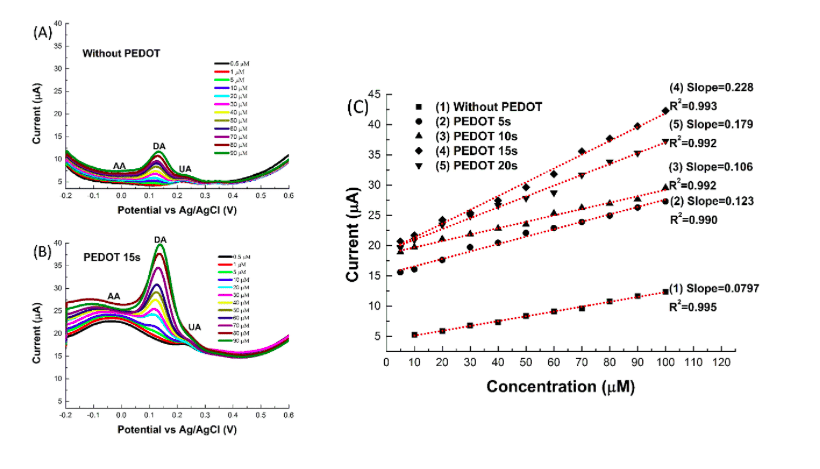
Dopamine is a critical neurotransmitter and a clinically important biomarker in the human body. The abnormalities of dopamine levels can potentially lead to various neurological disorders like Parkinson’s and Alzheimer’s diseases.
Therefore, the rapid point-of-care recognition of dopamine levels would contribute to the advancement of nerve physiology and assist in diagnosis. Therefore, developing a single-use point-of-care dopamine sensor with excellent sensitivity and selectivity is of great interest.

(Republished with permission from Elsevier from https://doi.org/10.1016/j.bios.2018.02.031)
The electrodes that use carbon-based nanomaterials have shown a great potential in various sensing devices. In that regard, graphene is a two-dimensional carbon material with unique properties: excellent conductivity, electrochemical activity, and a large surface area. Graphene is considered an excellent material platform for the development of electrochemical devices, including sensors, with a high-performance level. However, the scalable, low-cost production of graphene is a major issue that researchers of graphene would like to solve.
Laser scribed graphene (LSG) is a new member of the graphene family [1]. Laser scribing provides a one-step route for graphene materials. In one approach, the LSG electrodes are generated by irradiation of a polyimide sheet with a universal CO2 laser. The resulting LSG was discovered to consist of few-layer graphene with excellent electrical and thermal conductivity and prominent electrochemical performance [2]. The advantage of the LSG process is its cost efficiency compared with other graphene production methods, such as chemical vapor deposition (CVD), liquid phase exfoliation, and chemical reduction of graphene oxide.
In their recent report, Ph.D. candidate Guangyuan Xu, working in the laboratories of Prof. Jadranka Travas-Sejdic at the University of Auckland, New Zealand, developed a disposable dopamine-sensing device based on a modification of polyimide-LSG electrodes with a conducting polymer, poly(3,4-ethylenedioxythiophene) (PEDOT). This work is the first to combine the unique electronic properties of LSG and PEDOT to make a superior sensing electrode for dopamine. The work has demonstrated that the active surface area of PEDOT-modified LSG electrodes is significantly larger compared to that of parent LSG electrodes, leading to better sensing. The PEDOT-modified LSG electrode measures the electrocatalytic activity towards the dopamine oxidation reaction. The PEDOT-modified LSG sensor also shows a significantly enhanced selectivity to dopamine sensing in the presence of common interference substances, in particular, ascorbic acid (AA) and uric acid (UA) (Figure 1).

Figure 1. (A) Cyclic voltammetry of LSG and PEDOT- modified LSG electrodes in PBS electrolyte containing 1×10-3 M AA, 1×10-3 M DA, and 1×10-3 M UA (scan rate of 50 mV s−1). (B) Differential pulse voltammetry response of LSG and PEDOT- modified LSG electrodes in PBS solution consisting of 1×10-3 M AA, 40 ×10-6 M DA, and 40×10-6 M UA. Copyright from [3]. (Republished with permission from Elsevier from https://doi.org/10.1016/j.bios.2018.02.031)

Figure 2. Differential pulse voltammetry responses of different concentrations of dopamine in a mixture comprising 30 × 10−6 M AA and 4 × 10−6 M UA using (A) bare LSG, and (B) 15 s PEDOT-LSG amended sensors. (C) Calibration plots of the dopamine concentrations versus anodic peak current: symbols demonstrate the experimental data and the lines are linear fits. Copyright from [3]. (Republished with permission from Elsevier from https://doi.org/10.1016/j.bios.2018.02.031)
Figures 1 and 2 are reused from Biosensors and Bioelectronics, Vol 107, Guangyuan Xu, Zahraa A. Jarjes, Valentin Desprez, Paul A. Kilmartin, Jadranka Travas-Sejdic., Sensitive, selective, disposable electrochemical dopamine sensor based on PEDOT-modified laser scribed graphene, Pages 184-191, Copyright (2018), with permission from Elsevier.
References:
- El-Kady, M.F., et al., Laser Scribing of High-Performance and Flexible Graphene-Based Electrochemical Capacitors. Science, 2012. 335(6074): p. 1326-1330.
- Lin, J., et al., Laser-induced porous graphene films from commercial polymers. Nature Communications, 2014. 5: p. 5714.
- Xu, G., et al., Sensitive, selective, disposable electrochemical dopamine sensor based on PEDOT-modified laser scribed graphene. Biosensors and Bioelectronics, 2018. 107: p. 184-191.








